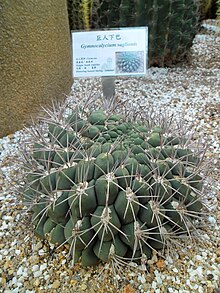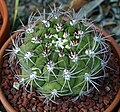Gymnocalycium saglionis
| Gymnocalycium saglionis | |
|---|---|

| |
| Spines are recurved | |

| |
| Large, mature Gymnocalycium saglionis in Hong Kong Park | |
| Scientific classification | |
| Kingdom: | Plantae |
| Clade: | Tracheophytes |
| Clade: | Angiosperms |
| Clade: | Eudicots |
| Order: | Caryophyllales |
| Family: | Cactaceae |
| Subfamily: | Cactoideae |
| Genus: | Gymnocalycium |
| Species: | G. saglionis
|
| Binomial name | |
| Gymnocalycium saglionis | |
| Synonyms[2] | |
|
List
| |
Gymnocalycium saglionis, the giant chin cactus, is a globular cactus species endemic to northwest Argentina.
Description
[edit]Gymnocalycium saglionis is known to grow very slowly, and grow best in warm and part shady conditions, but tolerate extremely bright situations although they are likely to suffer from sun scorch or stunted growth if over exposed to direct sunlight during the hottest part of the day in summer.
The body can range from dull-green or blue-green, almost cylindrical more or less flattened up to 40 cm (16 in) in diameter, up to 90 cm (35 in) tall. Spines can grown to 3–4 cm (1.2–1.6 in) long, colors varies from yellowish-brown, reddish or white becoming grey with time which contrast well against the green body, 1−3 centrals and 10−15 radials bent against the stem.
Spines become bright red when wet.
Flowers 3.6 cm (1.4 in) long, white or reddish, often more than one simultaneously. Fruits globular, reddish or dark pink, splits sideways with tiny, shiny black brown seeds.
-
Young plant
-
Young plants
-
Plant with flower.
-
Flowers - details
-
Plant with two ripe fruits
-
Fruit cracking open
Distribution
[edit]The cacti's most common native habitats are withinin the Argentine provinces of Salta, Tucuman, Catamarca, San Juan, and La Rioja at elevations between 240 to 2,600 meters. It grows on rocky soil with other low vegetation growing along with Acanthocalycium leucanthum and Leucostele terscheckii.[3][4]
Taxonomy
[edit]Gymnocalycium saglionis was first described in 1847 by François Cels and named it after J. Saglio, an important plant collector in France around 1840. Nathaniel Lord Britton and Joseph Nelson Rose moved this species to the genus Gymnocalycium in 1922.[5]
Cultivation
[edit]Gymnocalycium saglionis is cultivated as an ornamental plant around the world, and is commonly for sale.[6][7] Plants are large and have thick curved spines making this species popular among collectors.
In the UK it has gained the Royal Horticultural Society's Award of Garden Merit.[8]
References
[edit]- ^ Ortega-Baes, P.; Kiesling, R. (2017) [amended version of 2013 assessment]. "Gymnocalycium saglionis". IUCN Red List of Threatened Species. 2017: e.T152402A121534042. doi:10.2305/IUCN.UK.2017-3.RLTS.T152402A121534042.en. Retrieved 8 December 2023.
- ^ "Gymnocalycium saglionis (Cels) Britton & Rose". Plants of the World Online. Board of Trustees of the Royal Botanic Gardens, Kew. Retrieved 14 May 2021.
- ^ "Gymnocalycium saglionis (Cels) Britton & Rose". Plants of the World Online. 2022-07-04. Retrieved 2024-12-09.
- ^ Vallicelli, Valentino (2013-08-04). "Gymnocalycium saglionis". LLIFLE. Retrieved 2024-12-09.
- ^ Britton, Nathaniel Lord; Eaton, Mary E.; Rose, J. N.; Wood, Helen Adelaide (1919). The Cactaceae : descriptions and illustrations of plants of the cactus family. Washington: Carnegie Institution of Washington. doi:10.5962/bhl.title.46288.
- ^ "Gymnocalycium saglionis forma cristata".
- ^ "Gymnocalycium Pfeiffer ex Mittler (1844)". Cacti collection-Holzheu. Archived from the original on 6 April 2016.
- ^ "Gymnocalycium saglionis". www.rhs.org. Royal Horticultural Society. Retrieved 16 July 2020.
External links
[edit] Media related to Gymnocalycium saglionis at Wikimedia Commons
Media related to Gymnocalycium saglionis at Wikimedia Commons Data related to Gymnocalycium saglionis at Wikispecies
Data related to Gymnocalycium saglionis at Wikispecies







